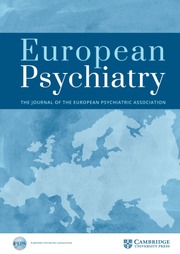No CrossRef data available.
Article contents
New Evidence of Heterogeneity in Social Anxiety Disorder: Defining Two Qualitatively Different Personality Profiles Taking into Account Clinical, Environmental and Genetic Factors.
Published online by Cambridge University Press: 15 April 2020
Abstract
To study qualitatively different subgroups of Social Anxiety Disorder (SAD) based on harm-avoidance (HA) and novelty-seeking (NS) dimensions.
One-hundred and forty-two university students with SAD (SCID-DSM-IV) were included in the study. The temperament dimensions HA and NS from the Cloninger's Temperament and Character Inventory were subjected to cluster analysis to identify meaningful subgroups. The identified subgroups were compared for sociodemographics, SAD severity, substance use, history of suicide and self-harm attempts, early life events, and two serotonin-transporter-gene-polymorphisms (5-HTTLPR and STin2.VNTR).
Two subgroups of SAD were identified by cluster-analysis: a larger (61% of the sample) inhibited subgroup of subjects with ‘high-HA/low-NS’, and a smaller (39%) atypical impulsive subgroup with high-moderate HA and NS. The two groups did not differ in social anxiety severity, but did differ in history of lifetime impulsive-related-problems. History of suicide attempts and self-harm were as twice as frequent in the impulsive subgroup. Significant differences were observed in the pattern of substance misuse. Whereas subjects in the inhibited subgroup showed a greater use of alcohol (p=0.002), subjects in the impulsive subgroup showed a greater use of substances with a high-sensation-seeking-profile (p<0.001). The STin2.VNTR genotype frequency showed an inverse distribution between subgroups (p=0.005).
Our study provides further evidence for the presence of qualitatively different SAD subgroups and the propensity of a subset of people with SAD to exhibit impulsive, high-risk behaviors.
- Type
- Article: 0481
- Information
- European Psychiatry , Volume 30 , Issue S1: Abstracts of the 23rd European Congress of Psychiatry , March 2015 , pp. 1
- Copyright
- Copyright © European Psychiatric Association 2015



Comments
No Comments have been published for this article.